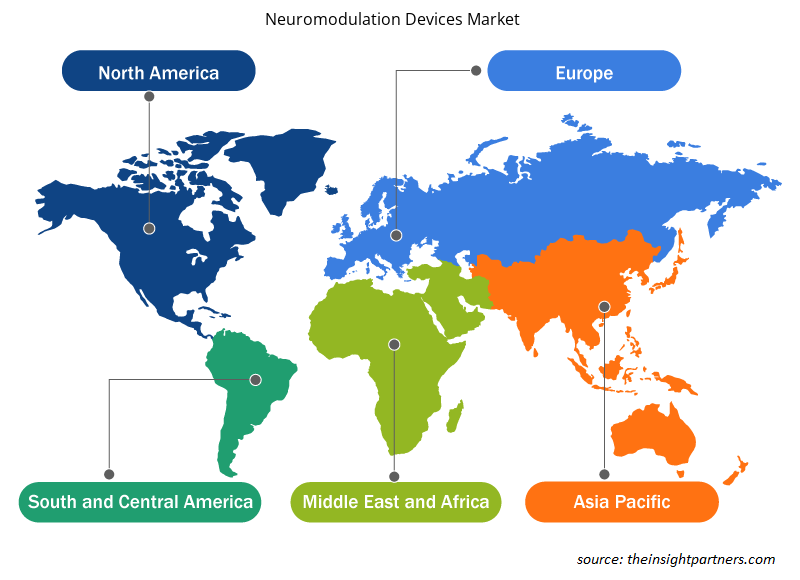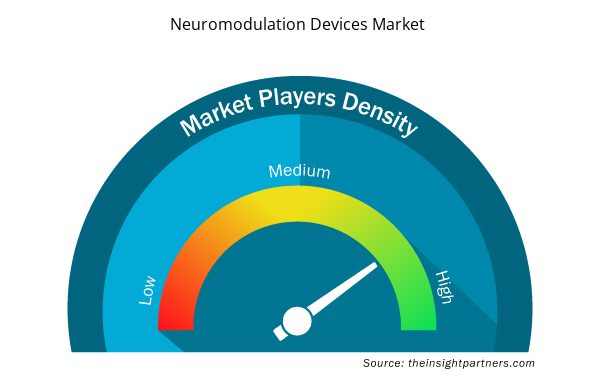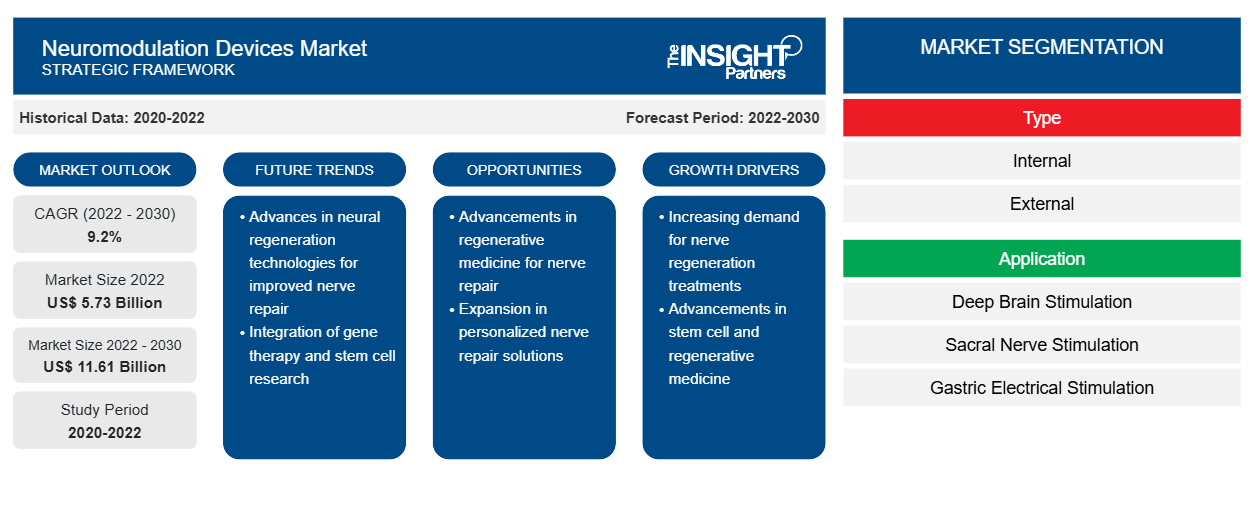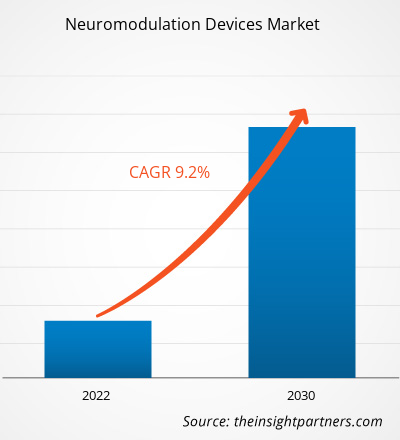[تقرير بحثي] بلغت قيمة سوق أجهزة تعديل الأعصاب 5.73 مليار دولار أمريكي في عام 2022 ومن المتوقع أن تصل إلى 11.61 مليار دولار أمريكي بحلول عام 2030. ومن المتوقع أن يسجل السوق معدل نمو سنوي مركب بنسبة 9.2٪ من عام 2022 إلى عام 2030.
رؤى السوق ووجهة نظر المحلل:
يتضمن التقرير آفاق النمو إلى جانب اتجاهات سوق أجهزة تعديل الأعصاب الحالية وتأثيرها المتوقع خلال الفترة المتوقعة.
إن استخدام تعديل الأعصاب ينمو بسرعة، مع وجود مجموعة واسعة من الأساليب القائمة على التكنولوجيا القابلة للزرع وغير الجراحية لعلاج الاضطرابات العصبية والنفسية. وقد أظهرت العلاجات مثل التحفيز القشري داخل الجمجمة (ICS)، والتحفيز المغناطيسي عبر الجمجمة (TMS)، والتحفيز العميق للدماغ (DBS)، والتحفيز بالتيار المباشر عبر الجمجمة (tDCS) نتائج واعدة عبر مجموعة من الاضطرابات العصبية والنفسية. إن أجهزة تعديل الأعصاب هي أدوات طبية متقدمة يمكنها ضبط نشاط الجهاز العصبي. تُستخدم التكنولوجيا لعلاج اضطرابات الحركة مثل خلل التوتر العضلي، ومرض باركنسون، والرعشة، والطنين، واضطراب الوسواس القهري، والإعاقات الحسية، والصرع، والتحكم في المثانة، والصداع، والألم المزمن، والسكتة الدماغية، وحالة الوعي الأدنى، والتشنج، وإصابة الحبل الشوكي. تساهم عوامل مثل ارتفاع حالات إصابة الحبل الشوكي وزيادة انتشار الاضطرابات العصبية في نمو حجم سوق أجهزة تعديل الأعصاب.
محركات السوق:
كبار السن معرضون للإصابة بالأمراض العصبية. ومن بين الاضطرابات العصبية الشائعة التي تصيب كبار السن الاعتلال العصبي ومرض باركنسون ومرض الزهايمر وخلل التوتر العضلي وغيرها. ووفقًا لإدارة الشؤون الاقتصادية والاجتماعية التابعة للأمم المتحدة، في عام 2022، كان هناك 771 مليون شخص على مستوى العالم تبلغ أعمارهم 65 عامًا أو أكثر. ومن المتوقع أن يصل عدد كبار السن إلى 994 مليونًا بحلول عام 2030 و1600 مليون بحلول عام 2050. وتتمتع دول مثل الولايات المتحدة وكندا بمعدلات انتشار عالية لاضطرابات الحركة والاضطرابات النفسية المرتبطة بتزايد أعداد كبار السن. ووفقًا لمؤسسة باركنسون، فإن أعراض باركنسون شائعة في متوسط عمر 60 عامًا.
تذكر الجمعية الكندية لعلم النفس أن اضطراب الوسواس القهري يؤثر على حوالي 2٪ من السكان في كندا. وتؤكد منظمة الصحة العالمية أن الصرع هو اضطراب عصبي يسبب النوبات ويؤثر على حوالي 50 مليون شخص في جميع أنحاء العالم. ووفقًا للأكاديمية الأمريكية لعلم الأعصاب، فإن السكتة الدماغية هي ثالث سبب رئيسي للوفاة في الولايات المتحدة، تليها مرض الزهايمر باعتباره السبب السادس الرئيسي للوفاة. تُظهر الإحصائيات من نفس المصدر أن ما يقرب من مليون أمريكي مصابون بمرض باركنسون، ويتم الإبلاغ عن ما لا يقل عن 60.000 حالة جديدة سنويًا. يؤدي الانتشار المتزايد للأمراض العصبية إلى جانب الاضطرابات المرتبطة بأسلوب الحياة مثل الاكتئاب والألم المزمن إلى زيادة اعتماد المنتجات المتقدمة تقنيًا.
لذلك، فإن ارتفاع عدد السكان المسنين المعرضين للأمراض العصبية، والانتشار المتزايد للأمراض، والوعي المتزايد بشأن العبء الهائل الذي تفرضه الاضطرابات العصبية، كل ذلك يدفع إلى نمو سوق أجهزة تعديل الأعصاب.
يركز علم الأعصاب على علاج الاضطرابات مثل السكتة الدماغية واضطرابات الصداع والتصلب المتعدد وغيرها من الحالات الشديدة. في السنوات الأخيرة، شهدنا نقصًا نسبيًا في القوى العاملة الماهرة في مجال الأعصاب حتى في البلدان المتقدمة. في الولايات المتحدة، يوجد أكثر من 5700 مستشفى؛ ومع ذلك، فإن هذه المستشفيات لديها أقل من 3700 جراح أعصاب. أحد العوامل البارزة المسؤولة عن عدم كفاية القوى العاملة في مجال جراحة الأعصاب هو عدم القدرة على إنتاج جراحي أعصاب مدربين بشكل كافٍ في فترة زمنية مناسبة. تتوفر مرافق طب الأعصاب ذات التكنولوجيا المتقدمة في المناطق الحضرية. ومع ذلك، يتم تقديم علاجات محدودة في المناطق الريفية بسبب نقص المتخصصين الخبراء. لذلك، فإن نقص جراحي الأعصاب المهرة يعيق نمو سوق أجهزة تعديل الأعصاب.
قم بتخصيص هذا التقرير ليناسب متطلباتك
ستحصل على تخصيص لأي تقرير - مجانًا - بما في ذلك أجزاء من هذا التقرير، أو تحليل على مستوى الدولة، وحزمة بيانات Excel، بالإضافة إلى الاستفادة من العروض والخصومات الرائعة للشركات الناشئة والجامعات
- احصل على أهم اتجاهات السوق الرئيسية لهذا التقرير.ستتضمن هذه العينة المجانية تحليلاً للبيانات، بدءًا من اتجاهات السوق وحتى التقديرات والتوقعات.
تقسيم التقرير ونطاقه:
تم إجراء "تحليل سوق أجهزة تعديل الأعصاب" من خلال النظر في القطاعات - النوع والتطبيق والمادة الحيوية والمستخدم النهائي.
التحليل القطاعي:
ينقسم سوق أجهزة تعديل الأعصاب، حسب النوع، إلى خارجي وداخلي. احتل قطاع تعديل الأعصاب الداخلي حصة سوقية أكبر في أجهزة تعديل الأعصاب في عام 2022. ومع ذلك، من المرجح أن يسجل قطاع تعديل الأعصاب الخارجي معدل نمو سنوي مركب أعلى خلال الفترة 2022-2030. يصف مصطلح "تعديل الأعصاب الداخلي" استخدام الأجهزة الطبية التي توفر التحفيز الكهربائي أو الكيميائي أو أشكال أخرى من التحفيز لأهداف عصبية محددة من أجل تعديل أو تغيير نشاط الجهاز العصبي. تُستخدم هذه التقنية لعلاج الأمراض العصبية الوعائية واضطرابات الحركة والصرع والألم المزمن وسلس البراز والبول.
من حيث المستخدم النهائي، يتم تقسيم سوق أجهزة تعديل الأعصاب إلى المستشفيات والعيادات والرعاية الصحية المنزلية. في عام 2022، هيمن قطاع المستشفيات على حصة سوق أجهزة تعديل الأعصاب. ونظرًا لتوسع العديد من المستشفيات والعيادات وزيادة الإنفاق الحكومي لبناء البنية التحتية للرعاية الصحية، يهيمن قطاع المستشفيات حاليًا على السوق. بالإضافة إلى ذلك، من المتوقع أن يؤدي شيخوخة السكان إلى انتشار أعلى للألم المزمن، مما يدفع الطلب على أجهزة تعديل الأعصاب في المستشفيات.
التحليل الإقليمي:
يتم تقسيم نطاق تقرير سوق أجهزة تعديل الأعصاب بشكل أساسي إلى أمريكا الشمالية (الولايات المتحدة وكندا والمكسيك) وأوروبا (إسبانيا والمملكة المتحدة وألمانيا وفرنسا وإيطاليا وبقية أوروبا) وآسيا والمحيط الهادئ (كوريا الجنوبية والصين والهند واليابان وأستراليا وبقية آسيا والمحيط الهادئ) والشرق الأوسط وأفريقيا (جنوب أفريقيا والمملكة العربية السعودية والإمارات العربية المتحدة وبقية الشرق الأوسط وأفريقيا) وأمريكا الجنوبية والوسطى (البرازيل والأرجنتين وبقية أمريكا الجنوبية والوسطى).
من حيث الإيرادات، سيطرت أمريكا الشمالية على حصة سوق أجهزة تعديل الأعصاب في عام 2022. إن الانتشار المتزايد للأمراض العصبية، والإنفاق المرتفع على البحث والتطوير، والعدد المتزايد من الموافقات على المنتجات من قبل إدارة الغذاء والدواء، والتقدم التكنولوجي، يعزز الطلب على أجهزة تعديل الأعصاب في المنطقة.
رؤى إقليمية حول سوق أجهزة تعديل الأعصاب
لقد قام المحللون في Insight Partners بشرح الاتجاهات والعوامل الإقليمية المؤثرة على سوق أجهزة تعديل الأعصاب طوال فترة التوقعات بشكل شامل. يناقش هذا القسم أيضًا قطاعات سوق أجهزة تعديل الأعصاب والجغرافيا في جميع أنحاء أمريكا الشمالية وأوروبا ومنطقة آسيا والمحيط الهادئ والشرق الأوسط وأفريقيا وأمريكا الجنوبية والوسطى.

- احصل على البيانات الإقليمية المحددة لسوق أجهزة تعديل الأعصاب
نطاق تقرير سوق أجهزة تعديل الأعصاب
| سمة التقرير | تفاصيل |
|---|---|
| حجم السوق في عام 2022 | 5.73 مليار دولار أمريكي |
| حجم السوق بحلول عام 2030 | 11.61 مليار دولار أمريكي |
| معدل النمو السنوي المركب العالمي (2022 - 2030) | 9.2% |
| البيانات التاريخية | 2020-2022 |
| فترة التنبؤ | 2022-2030 |
| القطاعات المغطاة | حسب النوع
|
| المناطق والدول المغطاة | أمريكا الشمالية
|
| قادة السوق وملفات تعريف الشركات الرئيسية |
|
كثافة اللاعبين في سوق أجهزة تعديل الأعصاب: فهم تأثيرها على ديناميكيات الأعمال
يشهد سوق أجهزة تعديل الأعصاب نموًا سريعًا، مدفوعًا بالطلب المتزايد من المستخدم النهائي بسبب عوامل مثل تفضيلات المستهلك المتطورة والتقدم التكنولوجي والوعي المتزايد بفوائد المنتج. ومع ارتفاع الطلب، تعمل الشركات على توسيع عروضها والابتكار لتلبية احتياجات المستهلكين والاستفادة من الاتجاهات الناشئة، مما يؤدي إلى زيادة نمو السوق.
تشير كثافة اللاعبين في السوق إلى توزيع الشركات أو المؤسسات العاملة في سوق أو صناعة معينة. وهي تشير إلى عدد المنافسين (اللاعبين في السوق) الموجودين في مساحة سوق معينة نسبة إلى حجمها أو قيمتها السوقية الإجمالية.
الشركات الرئيسية العاملة في سوق أجهزة تعديل الأعصاب هي:
- أبوت (مؤسسة سانت جود الطبية)
- شركة ليفانوفا المحدودة
- شركة بوسطن العلمية
- شركة اليفا للمعالجات العصبية
- بيوفينتوس
إخلاء المسؤولية : الشركات المذكورة أعلاه ليست مرتبة بأي ترتيب معين.

- احصل على نظرة عامة على أهم اللاعبين الرئيسيين في سوق أجهزة تعديل الأعصاب
المنافسة والشركات الرئيسية:
يركز تقرير سوق أجهزة تعديل الأعصاب على اللاعبين البارزين في السوق مثل Abbott (St. Jude Medical, Inc)، وLivaNova PLC، وBoston Scientific Corporation، وAleva Neurotherapeutics SA، وBioventus، وEnteroMedics Inc، وNevro Corporation، وNeuroPace Inc، وSynapse Biomedical Inc، وNeurosigma Inc. يمكن أن تساعد توقعات سوق أجهزة تعديل الأعصاب أصحاب المصلحة في التخطيط لاستراتيجيات النمو الخاصة بهم. تركز هذه الشركات على التقنيات الجديدة، وترقية المنتجات الحالية، وتوسيع السوق لتلبية الطلب المتزايد من المستهلكين في جميع أنحاء العالم. وفقًا للبيانات الصحفية للشركة، فيما يلي بعض التطورات الرئيسية الأخيرة:
- في أغسطس 2023، حصلت شركة Medtronic plc على موافقة علامة CE لجهاز تحفيز النخاع الشوكي القابل لإعادة الشحن Inceptiv. وهو أول جهاز تحفيز النخاع الشوكي القابل لإعادة الشحن من Medtronic يوفر ميزة الحلقة المغلقة التي تستشعر الإشارات البيولوجية الفريدة لكل شخص وتضبط التحفيز لحظة بلحظة، حسب الحاجة، للحفاظ على انسجام العلاج مع حركات الحياة اليومية.
- في أغسطس 2023، حصلت شركة Abbott على موافقة إدارة الغذاء والدواء الأمريكية (FDA) لنظام Proclaim Plus الجديد لتحفيز النخاع الشوكي (SCS) الذي يتميز بعلاج FlexBurst360. يوفر علاج FlexBurst360، وهو الجيل التالي من تحفيز BurstDR الخاص بشركة Abbott، تغطية للألم في ستة مناطق من الجذع و/أو الأطراف. كما يسهل البرمجة التي يمكن تعديلها وفقًا للاحتياجات العلاجية للشخص.
- التحليل التاريخي (سنتان)، السنة الأساسية، التوقعات (7 سنوات) مع معدل النمو السنوي المركب
- تحليل PEST و SWOT
- حجم السوق والقيمة / الحجم - عالميًا وإقليميًا وقطريًا
- الصناعة والمنافسة
- مجموعة بيانات Excel



Report Coverage
Revenue forecast, Company Analysis, Industry landscape, Growth factors, and Trends

Segment Covered
This text is related
to segments covered.

Regional Scope
North America, Europe, Asia Pacific, Middle East & Africa, South & Central America

Country Scope
This text is related
to country scope.
الأسئلة الشائعة
The neuromodulation device market, based on end user, segmented into hospitals, clinics, and home healthcare. In 2022, the hospitals segment dominated the neuromodulation devices market share.
Asia Pacific is expected to be the fastest growing region in the neuromodulation device market. The rising prevalence of neurological diseases and the development of neuromodulation devices are likely to enhance the market's growth in the coming years. China is among the most populated countries in the world, and the country has a maximum number of patients suffering from neurological disorders.
The neuromodulation device market, based on application, is segmented into metallic, polymeric, and ceramic. In 2022, the metallic segment dominated the market share. However, the polymeric segment is likely to register the highest CAGR during 2022–2030.
The neuromodulation device market, based on application, is segmented into deep brain stimulation (DBS), sacral nerve stimulation (SNS), gastric electrical stimulation (GES), spinal cord stimulation (SCS), and vagus nerve stimulation (VNS). The spinal cord stimulation segment held the largest market share in 2022 and is expected to record the highest CAGR in the market during 2022–2030.
The neuromodulation device market, based on type, is bifurcated into external and internal. The internal neuromodulation segment held a larger neuromodulation devices market share in 2022. However, the external neuromodulation segment is likely to register a higher CAGR during 2022–2030.
US holds the largest market share in neuromodulation device market. the incidence of neurovascular diseases is rising significantly, and it is among the leading causes of death across the country. Rising incidence of neurological diseases such as Parkinson's disease (PD), increasing awareness about neurological disorders, and growing investments in developing transcranial stimulators are among the main factors driving the overall neuromodulation devices market growth in the US.
The neuromodulation device market majorly consists of the players such as Abbott (St. Jude Medical, Inc.), LivaNova PLC, Boston Scientific Corporation, Aleva Neurotherapeutics SA, Bioventus, EnteroMedics Inc, Nevro Corporation, NeuroPace Inc, Synapse Biomedical Inc, Neurosigma Inc among others.
The factors that are driving growth of the market are the rising cases of spinal cord injury and increasing prevalence of neurological disorders.
Neuromodulation use is growing rapidly, with a wide range of implantable and noninvasive technology-based methods for the treatment of neuropsychiatric and neurological disorders. Therapies such as intracranial cortical stimulation (ICS), transcranial magnetic stimulation (TMS), deep brain stimulation (DBS), and transcranial direct current stimulation (tDCS) have shown promising results across a range of neuropsychiatric and neurological disorders. Neuromodulation devices are advanced medical instruments that can adjust the activity of the nervous system. The technology is used to treat movement disorders such as dystonia, Parkinson’s disease, and tremor; tinnitus; obsessive compulsive disorder; sensory disabilities; epilepsy; bladder control; headache; chronic pain; stroke; minimally conscious state; spasticity; and spinal cord injury.
Trends and growth analysis reports related to Life Sciences : READ MORE..
The List of Companies - Neuromodulation Devices Market
- Abbott (St. Jude Medical, Inc.)
- LivaNova PLC
- Boston Scientific Corporation
- Aleva Neurotherapeutics SA
- Bioventus
- EnteroMedics Inc.
- Nevro Corporation
- NeuroPace Inc.
- Synapse Biomedical, Inc.
- Neurosigma, Inc
The Insight Partners performs research in 4 major stages: Data Collection & Secondary Research, Primary Research, Data Analysis and Data Triangulation & Final Review.
- Data Collection and Secondary Research:
As a market research and consulting firm operating from a decade, we have published and advised several client across the globe. First step for any study will start with an assessment of currently available data and insights from existing reports. Further, historical and current market information is collected from Investor Presentations, Annual Reports, SEC Filings, etc., and other information related to company’s performance and market positioning are gathered from Paid Databases (Factiva, Hoovers, and Reuters) and various other publications available in public domain.
Several associations trade associates, technical forums, institutes, societies and organization are accessed to gain technical as well as market related insights through their publications such as research papers, blogs and press releases related to the studies are referred to get cues about the market. Further, white papers, journals, magazines, and other news articles published in last 3 years are scrutinized and analyzed to understand the current market trends.
- Primary Research:
The primarily interview analysis comprise of data obtained from industry participants interview and answers to survey questions gathered by in-house primary team.
For primary research, interviews are conducted with industry experts/CEOs/Marketing Managers/VPs/Subject Matter Experts from both demand and supply side to get a 360-degree view of the market. The primary team conducts several interviews based on the complexity of the markets to understand the various market trends and dynamics which makes research more credible and precise.
A typical research interview fulfils the following functions:
- Provides first-hand information on the market size, market trends, growth trends, competitive landscape, and outlook
- Validates and strengthens in-house secondary research findings
- Develops the analysis team’s expertise and market understanding
Primary research involves email interactions and telephone interviews for each market, category, segment, and sub-segment across geographies. The participants who typically take part in such a process include, but are not limited to:
- Industry participants: VPs, business development managers, market intelligence managers and national sales managers
- Outside experts: Valuation experts, research analysts and key opinion leaders specializing in the electronics and semiconductor industry.
Below is the breakup of our primary respondents by company, designation, and region:

Once we receive the confirmation from primary research sources or primary respondents, we finalize the base year market estimation and forecast the data as per the macroeconomic and microeconomic factors assessed during data collection.
- Data Analysis:
Once data is validated through both secondary as well as primary respondents, we finalize the market estimations by hypothesis formulation and factor analysis at regional and country level.
- Macro-Economic Factor Analysis:
We analyse macroeconomic indicators such the gross domestic product (GDP), increase in the demand for goods and services across industries, technological advancement, regional economic growth, governmental policies, the influence of COVID-19, PEST analysis, and other aspects. This analysis aids in setting benchmarks for various nations/regions and approximating market splits. Additionally, the general trend of the aforementioned components aid in determining the market's development possibilities.
- Country Level Data:
Various factors that are especially aligned to the country are taken into account to determine the market size for a certain area and country, including the presence of vendors, such as headquarters and offices, the country's GDP, demand patterns, and industry growth. To comprehend the market dynamics for the nation, a number of growth variables, inhibitors, application areas, and current market trends are researched. The aforementioned elements aid in determining the country's overall market's growth potential.
- Company Profile:
The “Table of Contents” is formulated by listing and analyzing more than 25 - 30 companies operating in the market ecosystem across geographies. However, we profile only 10 companies as a standard practice in our syndicate reports. These 10 companies comprise leading, emerging, and regional players. Nonetheless, our analysis is not restricted to the 10 listed companies, we also analyze other companies present in the market to develop a holistic view and understand the prevailing trends. The “Company Profiles” section in the report covers key facts, business description, products & services, financial information, SWOT analysis, and key developments. The financial information presented is extracted from the annual reports and official documents of the publicly listed companies. Upon collecting the information for the sections of respective companies, we verify them via various primary sources and then compile the data in respective company profiles. The company level information helps us in deriving the base number as well as in forecasting the market size.
- Developing Base Number:
Aggregation of sales statistics (2020-2022) and macro-economic factor, and other secondary and primary research insights are utilized to arrive at base number and related market shares for 2022. The data gaps are identified in this step and relevant market data is analyzed, collected from paid primary interviews or databases. On finalizing the base year market size, forecasts are developed on the basis of macro-economic, industry and market growth factors and company level analysis.
- Data Triangulation and Final Review:
The market findings and base year market size calculations are validated from supply as well as demand side. Demand side validations are based on macro-economic factor analysis and benchmarks for respective regions and countries. In case of supply side validations, revenues of major companies are estimated (in case not available) based on industry benchmark, approximate number of employees, product portfolio, and primary interviews revenues are gathered. Further revenue from target product/service segment is assessed to avoid overshooting of market statistics. In case of heavy deviations between supply and demand side values, all thes steps are repeated to achieve synchronization.
We follow an iterative model, wherein we share our research findings with Subject Matter Experts (SME’s) and Key Opinion Leaders (KOLs) until consensus view of the market is not formulated – this model negates any drastic deviation in the opinions of experts. Only validated and universally acceptable research findings are quoted in our reports.
We have important check points that we use to validate our research findings – which we call – data triangulation, where we validate the information, we generate from secondary sources with primary interviews and then we re-validate with our internal data bases and Subject matter experts. This comprehensive model enables us to deliver high quality, reliable data in shortest possible time.


 احصل على عينة مجانية لهذا التقرير
احصل على عينة مجانية لهذا التقرير